In search of Colombian Crown Jewels
by Caleb Thimell
Reprinted from "Crown Jewels of the Wire", June 1991, page 10
I first became interested in insulators when a relative gave me some old
fruit jars belonging to her mother that had been in her basement. She then
handed me a beautiful green aqua CD 115 Hemingray, telling me it was found on
the farm belonging to her husband's grandfather. Since I was actively
researching my family's tree, I became interested in this insulator and its
historical ties to my family. I had already gained an appreciation for antique
glass, so naturally I became curious to look into the hobby.
In January 1990 I
decided to subscribe to Crown Jewels. I was very interested to find out what
kinds of insulators were available in the U.S. and if I might be able to find
some when I arrived in Colombia, my next assignment in the U.S. Navy. I wrote to
Carol McDougald and asked her to "put me on all insulator mailing
lists". I added that I would be living in Guatemala for 7 weeks for
Spanish training and would be moving to Colombia in June and asked her to
forward C.J. there for me. Carol wrote back encouraging me to look for Colombian
"crown jewels." She added that she and Marilyn Albers were very
interested in buying any insulators I could find, as well as receiving
information on manufacturers. I decided I wanted to be a member of NIA after
getting my first magazine.
Upon arriving in Guatemala I immediately began to
search. My first adventure was during a climb up a volcano over 12,000 feet! I
remember spotting dark green sombrero insulators and excitedly taking their picture.
But later I learned they were common French-exported Sedivers. In another
effort, I scoured all the antique shops I could find in Antigua, but only turned
up common American Whitall Tatum and Hemingray signals. I did spot one purple
and several blackglass green tolls, but they were still in use. Upon arrival in
Colombia I kept "looking up" as Carol and Marilyn had advised, but it
took me several months before I spotted my first glass insulator, a CD 167
Armstrong in Blackglass Amber (I thought it was Colombian at the time). As a new
collector, I could only imagine how I was going to get one.
My first success
came one evening when riding home from work, I spotted several downed poles in
my neighborhood! ! I nearly died with excitement at the prospect of finally
holding some Colombian insulators. I walked down to the site with a pair of vice
grips and a plastic bag to carry my haul. But upon arrival, I only saw porcelain
U-2278 NN's. But it was nonetheless my first and only available insulator, so I
decided to free one from a pole amidst the destruction I saw around me. Several
pieces were destroyed on site and used to fill holes for new poles already
planted into the ground. Upon closer inspection I saw a couple of broken U- (?)
T-Bars! I searched to find all the pieces to glue them together, but they
weren't to be found. I went home with a couple U-2278s, one U-1690 and one CD 167 Armstrong in amber blackglass. I was excited and
disappointed at the same time. Deep within me, however, I knew this was just the
beginning.
My first plan of attack was to see if insulators might be listed in
the yellow pages. At first I looked under electrical parts/supplies. I found a
few shops close to my apartment and began my quest. At first nobody seemed to
know what an insulator was. It was very frustrating because I thought I was
mispronouncing it in Spanish. But at last I came to a shop and was shown 2 GAMMA
porcelain spools! And they were nice because they were stamped in English:
"Made in Colombia 1990". I decided to send samples off to Carol and
Marilyn right away. Boy, did I make their day.
After having scoured all
the electrical parts shops in my area, I decided to search the yellow pages
again. This time I looked under the Electrical Insulator heading. Would you
believe it? There were about a dozen shops listed. . Matrimol LTDA advertised
pin-type insulators! I was so excited that I took a taxi to the plant. It was
listed as having a factory on site. Upon arrival I was confused to see what
appeared to be a residential building, with no sign. Nevertheless, I inquired if
insulators were sold there in my somewhat rusty Spanish. I received a yes, and
was escorted up a few flights of stairs. I was asked to have a seat and the
plant manager would assist me in a moment. I immediately spotted a display
case full of insulators -- some glass ponies, porcelain signals, and others in an
unusual epoxy. The manager arrived and I asked where I could obtain the
displayed insulators. She told me that the glass pieces were American and the porcelains were made in Medellin,
Colombia. As a new collector I hesitantly took her word for it. The porcelain
pieces I thought would be unobtainable since there were being produced in the
most dangerous place in Colombia. I then inquired about the epoxy insulators
Matrimol produced. The manager promised and later mailed me a copy of their
catalog.
With determination to find something on my day off, I inquired where I
might find the porcelain pieces locally. I was given an address on the other
side of town. The taxi fare was rising quickly, and I still had nothing to show
for my efforts.
Upon arriving at Electro Gamma, a local electrical parts
distributor, I was greeted by a painted trademark of GAMMA insulators on the
outside wall! I asked the driver to wait for me while I confirmed they sold
insulators. I forgot all doubts as I was handed a GAMMA Sim CD 155 (U-?), a
U-221, , and a strain insulator. I then inquired if they had a copy of a GAMMA
catalog. They did! I asked and they xeroxed a copy for me. I was told the Sim CD
155 would probably be given a new U-number! Was I ever a happy collector! And
just as exciting, I had discovered a Colombian porcelain insulator manufacturer!
Reading through the catalog I learned that GAMMA's insulators were produced
using the wet process and "a good design technology that guarantees that
the pieces can withstand strong electro-mechanical forces without losing the
dialectic properties." The earliest GAMMA I found is dated 1966. The
catalog confirms it's manufacturing beginnings "date back twenty five years
with electric porcelain and 100 years with ceramics."
I've done some research and based on
my samples, I've been able to determine the following markings on GAMMA
insulators associated with specific manufacturing dates:
|
1966-1968 |
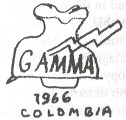 |
|
1968-1975 |
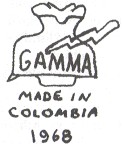 |
|
1976-Present |
 |
With catalog and GAMMA's in hand I was feeling mighty fine. I paid the
patient taxi driver and decided to look around in the neighborhood. I spotted a
glass insulator sitting on a window display shelf. I was so excited and went
inside to inquire about it. Upon closer inspection, it turned out to be a CD 221
Ice Green Hemingray. As I looked around I spotted a shelf behind the counter,
laden with dozens of glass and porcelain insulators!! I wanted to leap over the
counter and rescue them! Instead I courteously asked if I could look at them. The sales
girl (after attempting to determine what electrical project I was working on)
agreed, and I about died when I saw a CD 155 TELECOM in blue-grey and a CD 203
TELECOM in dark vibrant peach with drips!! I had never heard of this name on an
insulator, but recognized it immediately as Colombia's long distance telephone
company! A little more movement of pieces uncovered a CD 122.2 NN and a CD 116.6
NN (Both recently assigned CD numbers!). Unfortunately many of the pieces were
damaged, but I bought the dark peach, a couple of CD 155 TELECOM's, the
blue-grey NN's, and some similar to a CD 155 GAMMA's (U-?). I asked the
shopkeeper if she knew who made the 2 NN's and she said that PELDAR did. I never
heard of that company but decided to look into it. I went home that day with
boxes of jewels in hand and a big smile on my face.
The next weekend I decided
it was time to visit PELDAR, S.A., which turned out to be one of the largest
glass manufacturers in Colombia owned by Owens Glass of Ohio! I met with the
director of sales in the corporate headquarters in Bogota. I had copies of Glass
Insulators From Outside North America and Worldwide Guide to Porcelain
Insulators ready in hand. The director was amazed at my interest in insulators
and wondered if I wanted them for my business. I said that it was a hobby of
mine, but that I was very interested in obtaining more information on Colombian
insulators to have it published. He went on to explain that PELDAR to his
knowledge didn't produce insulators. I was very disappointed. The man wasn't completely sure of himself, and the company
president was too busy to be bothered. But he suggested I go directly to TELECOM
for more information. I guess I couldn't hide my disappointment, and
before I knew it the kind man was escorting me directly to TELECOM headquarters
and even directed me to the appropriate office! He explained that when he
visited Owens Glass Headquarters in Ohio, everyone was so kind to him that he
wanted to repay a favor to an American!
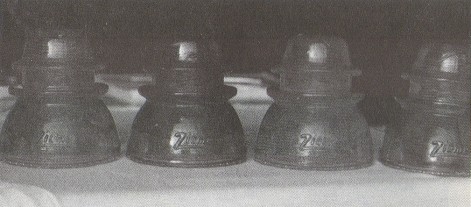
Four of the blue and green CD 154 ZICME insulators found to date
Everyone at TELECOM was surprisingly
helpful under the circumstances (the company was on strike and the government is
in the midst of trying to sell it to private investors and a big rally was being
planned that night outside the building I was in!) After visiting several
offices, I met with Alberto Royero, a physical engineer for the company. He
pulled out an old chart that listed several companies who had contracts with
TELECOM to provide them with insulators in the past. I was excited and copied
down the names of ITT of Colombia and Abengoa, S.A., who were listed as providing glass pieces, and
Electroporcelana Gamma and UMERCA LTDA with porcelain. Unfortunately Mr. Royero
wasn't sure who made the "CD 155 and CD 203's" I had found. Although he
thought that ITT of Colombia probably did. He gave me business cards of
distributors that TELECOM does business with. However, only one of them sold
TELECOM's and they were in very short supply -- most in poor condition. , Perhaps
whoever made them is no longer in business? Their names were not listed in the
yellow or white pages. It continues to be a mystery who these companies are.
Perhaps they are located in one of Colombia's other two large industrial cities
-- Medellin or Barranquilla.
A few weeks later I returned to my
"insulator hunting grounds" (electrical parts shops) in search of some
special pieces. My big goal today was to find a ZICME! A few weeks earlier I
found ZICME listed in the phone book and took a drive out to its warehouse. In
an empty field in front of an old warehouse stood a sign that said: "PELICME LTDA, DISTRIBUTORS OF ZICME PRODUCTS". I knocked on the
door with no answer. I had photos of ZICME's that were found in Colombia, had
seen ZICME listed in the phone book, and had received many promises from
shopkeepers to find them, but now having seen the warehouse I was sure I would.
As I was strolling through the usual neighborhood, I decided to explore a little
more in a different area. I found a small "hole in the wall" shop that
had a little sign -- Electrical Parts, Used. I decided to check it out. I said my
usual routine and was escorted to a back room. As I walked in, I saw a pile of
insulators -- glass in one room and porcelain in another. As I dug through the
pile I found four CD 154 bubbly green and blue tinged ZICME's!! I picked them up
like they were pure gold. My legs even began to shake! Unfortunately three of
the four had noticeable chips on them. But since there were only two CD 154
ZICME's known at the time, I couldn't help being excited!! I ended up spending several hours digging through the piles. I even handled a couple broken
T-Bars (Sim U-2085's). Altogether I've located 6 CD 154 Zicmes, 2 with a bold
embossing.
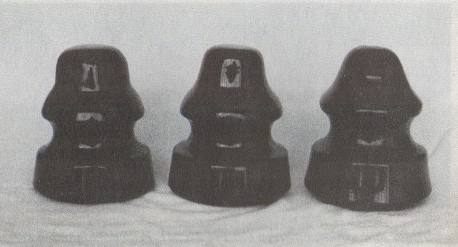
GAMMA signal (sim U-2239) with two unique variations
As I dug around, I saw something that really made my day -- a couple of
boxes labeled "COOPERATIVA INTEGRAL DE VIDRIERAS" and COOVINAL
listed at the bottom -- filled with the NN insulators. First evidence of a
Colombian glass insulator manufacturer! And later on I was able to find a
factory outlet, where I surveyed their catalog. Accordingly, COOVINAL was founded
in 1944 by Colombians using European technology and capital, Colombian
craftsmanship, and within time, became one of the largest factories of its kind
in Latin America. Today they export a large portion of their production. They
are big producers of glassware, dishes, decorative items and CD 122.2, CD 116.6,
CD 1049 insulators and likely the CD 122.2 NN peak-dome insulator. As of this
writing only 8 of these peak-dome variations are known to exist, with 4 of them in
mint.
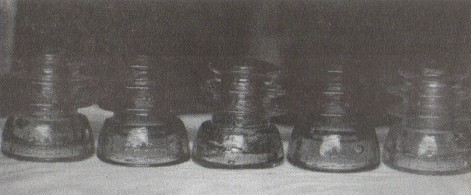
Rainbow of CD 203 TELECOMs - dark peach, pink smoke with
milky swirls, pink No
Name, medium smoke, clear with blue tint
A few weeks later I had returned to to my sole source for CD 203 TELECOM's. I had tried unsuccessfully to view the
supply of insulators on the shelf up close, but each
time the owner said there was nothing more to see. But this Saturday the owner
was out and his son was working. I asked to look at the stock of insulators and
the young man eagerly led the way. What I saw were GAMMA porcelains, a supply of
E.S.A. CD 154' s ( without the usual markings), and some SETO porcelains from
Japan. Upon closer inspection I located 7 CD 122.2 NN's with a peaked dome! This
variation wasn't listed in COOVINAL's catalog, so I eagerly bought them. And as
if that weren't enough to make my day, when moving a few pieces
around I found the most beautiful insulator I had ever seen in all of Colombia --
a peacock blue CD 1050 NN! (This is a brand new CD number). I was on cloud nine
for a few weeks after that discovery. I later learned that a CD 1050 in cobalt
blue was found in Colombia around the same time as mine, and brought back for
Marilyn!
What a coincidence that two rare
beauties were found in totally different parts
of the country and given to two Colombian insulator
collectors at the same time is just astounding
to me!
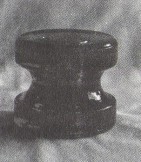
CD 1050 peacock Colombian spool
My most recent discovery went something like this. I woke up this morning with a new determination to obtain some T-Bar insulators.
Somehow I felt I was going to get one, but where I didn't know. I decided to start
the day at Pasaje Electricos, the small electrical shop in Bogota that has
been helping me find insulators. Upon arrival, I was greeted by a U-2239 GAMMA
with the rare peak dome variation! Alva Sanchez said she had some unemployed
workers out looking for insulators for me and found this one. I was excited as this was
only
the second of this variation I have found, both having the 1972 date.
Upon
leaving, I remembered a T-Bar insulator I had seen on a building front in Bogota.
I attempted to buy it previously, but was told to return when the owner would
be there. I promised the saleswoman I would return, and that was over one month
ago! Just maybe this time I could convince her to sell it to me. Upon arriving,
I saw two young men painting the store's sign -- within reach of the Sim U-2085
T-Bar!! This time using a photo of a T-Bar found in Colombia, I explained to the
owner that I wanted to buy the T-Bar insulator for my collection. I offered her
10,000 pesos for it and one worker replied, "how about $100.00?!'' I said
no way. The woman started getting nervous, fearing it belonged to the electric company (Energia Bogota). I told her to not worry
because it was very old and no longer in use. This seemed to satisfy her as one
of the workers leaped up the ladder to retrieve it! However it had been there
for years and so it took one hack saw, two blades, and patience with a crying
boy and nervous shopkeeper before I finally got it! But it was worth every
minute! And now I have two more friends helping me in the search for Colombian
Crown Jewels.
Each day I'm getting closer to obtaining the elusive SCA Zicme and
I hope it will be sooner than later. I have other exciting stories I would love
to share with you, but as fast as I could share, I'd probably make a new
discovery. Such is the life of an insulator collector in the "land of Juan
Valdez."
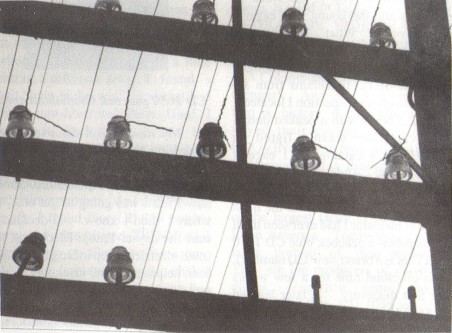
Believed to be a crossarm containing the elusive purple CD 154 Zicme
| 